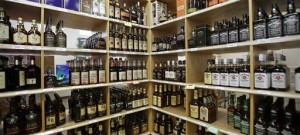SALT LAKE CITY — Alcohol sales in Utah increased again last year — likely an indication of a diversified population and a thriving tourism sector.
The $396 million in total sales in fiscal 2015 marked an eight percent rise from the previous year and are more than double the figure from a decade ago, show data released this week from Utah Department of Alcoholic Beverage Control. Sales have increased each year going back to 1996, the oldest year state data is available.
The rise is more than just the natural product of a state that has one-third more residents than it did 25 years ago. The average gallons of alcohol consumed per capita in the state has increased each of the past nine straight years. That rate was up just over four percent in 2015 from the previous year, and 53 percent from 2005.
The figures take into account sales of all alcohol except beer that contains less than four percent alcohol by volume, which can be purchased at grocery and convenience stores.

A steady influx of non-Mormon, out-of-state residents in the last 25 years, combined with Utah cementing its place as a tourist destination, is likely driving the surge in liquor sales, said Pam Perlich, senior research economist at the University of Utah.
From 1990 to 2010, about one in three new Utah residents were from a different state or country, she said.
The University of Utah, the state’s flagship university, has also seen a rise in out-of-state students. Those students make up 26 percent of undergraduates enrolled this year, up from 18 percent in 2005. Among graduate students, out-of-state students account for an even larger share: 47 percent, up from 42 percent in 2005.
Though as many as seven in 10 Utah residents are what Perlich describes as “cultural Mormons” with familial roots in the religion, the best estimate is that about 55 percent of Utah’s three million residents are active, devout Mormons who adhere to the religion’s prohibition on drinking alcohol.
“There’s a compositional shift in the state,” Perlich said. “We’re getting young professionals moving here from all over the country. The people are coming here are not predominantly LDS.”
Utah’s snow-capped mountains and red-rock national parks seem to be drawing more tourists to Utah.
Tourism-related tax revenue increased 11 percent from the previous year to $130 million in 2014, state figures show. State officials changed the methodology for gathering this statistic in 2013, so it’s not possible to compare to older figures.
But other metrics show a rise in tourism over the last decade. The state’s five national parks registered about seven visits in 2014, up 35 percent from 2005.
Another factor bringing more visitors is a recovering economy that has allowed corporations to spend money on conferences and conventions, Perlich said. The summer Outdoor Retailer Show drew about 27,000, many coming in from other states and able to have big dinners with drinks on the company tab.
Vacation is a time when people kick back and relax, and have drinks, Perlich said.
Utah is one of 19 states with state-run liquor sales. A portion of the profits, about $41 million this year, went to help fund school lunches and public safety, Department of Alcoholic Beverage Control spokeswoman Vickie Ashby said. Most of the profits, $95 million this year, went to the state’s general fund to be used as the Legislature determines.
Wine remains the most popular alcoholic choice in Utah with more than 8.2 million gallons consumed last year. But consumption of flavored malt beverages increased the most last year, by 12 percent.
Beer sales spiked by nine percent, the biggest jump in five years.
Millennial generation beer drinkers want a variety of taste and flavors, driving a spike in recent years in craft beers, said Jim Olsen, president of Utah Beer Wholesalers Association. That’s a contrast to beer drinkers 25 years ago who stuck with their favorite, such as Miller Genuine Draft or Coors, Olsen said.
“These young millennial types of drinkers don’t have one particular one,” Olsen said. “They’ll sit down at a social gathering and try a variety of beers.”




